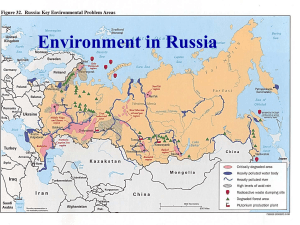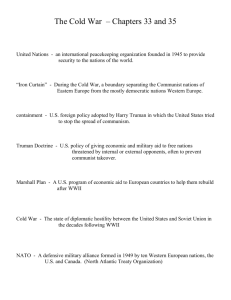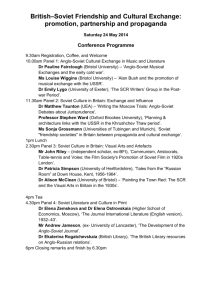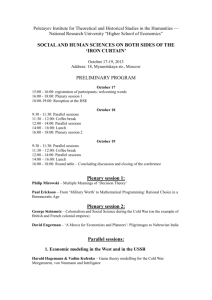Soviet Bloc Environment
advertisement
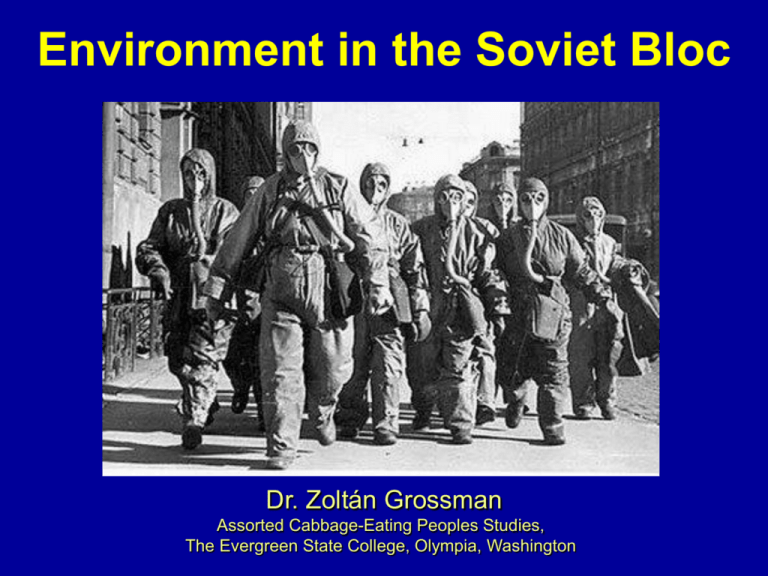
Environment in the Soviet Bloc Dr. Zoltán Grossman Assorted Cabbage-Eating Peoples Studies, The Evergreen State College, Olympia, Washington Environment in Russia Environment in Soviet Central Asia Engels’ Dialectics of Nature (1883) “We by no means rule over nature like a conqueror over a foreign people, like someone standing outside of nature--but that we… belong to nature and exist in its midst…” “We are…getting to know both the immediate and the more remote consequences of our interference with the traditional course of nature…. The more will men not only feel, but also know, their unity with nature, and thus the more impossible will become the senseless and antinatural idea of a contradiction between …man and nature.” Rosa Luxemburg (1917) Soviet Central Planning • “The means—industrialization— came permanently to replace the end—egalitarianism—as it was…expressed in the Bolshevik Revolution.” (Bailes) • Economic decisions made not by workers’ self-management, but central planners insensitive to local communities’ needs USSR was worse than West • 2.5 X air pollution of U.S. (per GNP) • 20% water unsafe • 1/3 of arable land affected by acid rain • Etc., etc. Why Soviet bloc was worse • Stalinist heavy industry • Expansion of agriculture – Khrushchev: “Virgin Lands” • “Inexhaustible” resources in large empire/bloc • Sacrifice for defense of Communist state Why Soviet bloc was worse • Little or no free opposition • Secrecy; lack of enforcement • Only capitalism harms nature • Need to “catch up” with (historic) West & capitalism Why Soviet bloc was worse • State legitimacy, selfsufficiency through technology • Aviator heroes, 1920s-40s • Space Race, 1950s-60s Soviet Technocracy • Technocratic institutions had the ear of the Kremlin (Konrád / Szelényi) • Leaders technicians; questioning of technology prevented • 80% of Politburo had high technical education, 1970s. • Many Western-recognized Soviet dissidents were also technocrats (Sakharov, etc.). WATER Aral Sea • Once the 4th largest inland body of water in the world. A series of dams was built to irrigate cotton. • Aral Sea reduced to about 25% of its 1960 volume, 4x salinity wiped out the fishery. • Pollutants became airborne as dust, causing significant local health problems. Interbasin water transfers (river diversions) Aral Sea Kara Kum Canal Amu Darya Size of Aral Sea Environmental damage estimated at $1.25 -$2.5 billion a year. Dnieper R. Ukraine Sea of Dniester R. Azov Moldova Crimea Danube R. Romania Don R. BLACK SEA Bulg. Bosporus Turkey Russia Georgia Sea of Azov Eutrophication (Algae growth) Metals plant on Dnieper River Lake Baikal Environmental objections to paper mills as early as 1960s Network with Lake Superior Gabcikovo Dams, Slovakia Conflict, protests between Slovakia and Hungary over diversion of Danube River in Gabcikovo/ Nagymaros project AIR & LAND Kola Peninsula, NW Russia Black Triangle GDR Devastation from acid rain, SO2, toxics POLAND CZECHOSLOVAKIA Pop., 1870 Pop., 1910 Canals & RR, Pre1914 Industry 19451989 Donbass & Kuzbass Donbass coal fields, E. Ukraine Kuzbass coal fields, W. Siberia Kalmykia European Buddhist Mongols Desertification Chemicals/ Salinization Oil development Sakha (Yakutia) • Siberian indigenous • Coal, metals mining • Logging Noril’sk nickel smelter Arctic Haze and Acid Rain MILITARIZATION Acid rain, Mining, Nuclear subs scuttled Kola Peninsula Toxic Soviet military bases Abandoned Soviet military bases in Central Europe, ex-GDRhave toxic wastes (like U.S. bases elsewhere.) Sverdlovsk anthrax, 1979 Bioweapons disaster, 79 cases (66 dead) in Yeltsin’s district Bombing civilian chemical plants Toxic cloud after NATO bombing of Pancevo plant in Yugoslavia, 1999 1st uranium mines in Czech Rep. Maria Sklodowska Curie, Polish-French scientist who discovered radium from Czech mines, 1890s Uranium mining in Hungary Roma (Gypsy) kids playing on radioactive mill tailings from Soviet uranium mine in Pécs (Like Native American kids in US). Mecsek Range miners threatened to flood mine in 1956 Revolution Soviet nuclear tests in Kazakhstan Genetic defects near Semey (Semipalatinsk) Kazakhs protest, network with Nevadans for 1996 ban Kyshtym waste disaster, 1957 Orphans – Explosion at Soviet weapons factory forces evacuation of over 10,000 people in Ural Mts. – Area size of Rhode Island uninhabited; 30 villages demolished; many cancers reported Novaya Zemlya NUCLEAR POWER Chernobyl disaster, April 1986 400 million people exposed in 20 countries “It Can’t Happen Here”: West Mirrors East • U.S. reaction to Chernobyl, 1986 – Blamed on Communism, secrecy, graphite reactor • Also Soviet reaction to Three-Mile Island, 1979 – Blamed on Capitalism, profit, pressurized-water reactor • US, Soviet industries covered for each other – No technology is 100% safe – Fukushima 2011 due to corporate profit & state secrecy Soviet media reaction to Three-Mile Island, 1979 • Literaturnaya Gazeta: Pennsylvania nearmeltdown was a “serious, major accident.” • Kommunist: Build nukes in less populated areas. • Izvestiya: “essentially minor unfavorable consequences were depicted in an extremely exaggerated form,” by an antinuclear movement that is a “tool” of Western oil companies (!) 8,000-10,000 premature deaths United Nations Scientific Committee of the Effects of Atomic Radiation (UNSCEAR), 2005 Half of deaths, many genetic defects in local contaminated zone My grandmother, by Luda Death of my life, by Marina Chernobyl is war, by Irena Beauty and the beast, by Helena Nothing escapes radiation, by Irena Chernobyl, our hell, by Eugenia Self-portrait, by Natasha Chernobyl’s political fallout • Secrecy stimulated opposition to nuclear power in GDR, Poland, Czechoslovakia (with Western activists) • Stimulated nationalism in Ukraine and Belarus, and Baltic republics that lost clean-up workers (strike by angry Estonian conscripts). • Gorbachev’s Glasnost (openness) stronger in short-term. • USSR weakened in long-term by questioning of the heart of technocratic power; collapsed within 5 years. Nuclear plants in Europe Transitions to Capitalism • Central Europe best world region to study transition from state-run socialist economy to privatized capitalist economy • Transitions uneven within and between different countries • State & global institutions still play roll in economy • Move from Primary/Secondary to Tertiary/Quaternary economy 1. Primary economic activities Extracting raw materials 2. Secondary economic activities Processing and manufacturing materials 3. Tertiary economic activities Sales, exchange, trading goods and services Stock exchange Call Centers Tourism 4. Quaternary activities Processing knowledge and information Positives since end of USSR • Democratization: NGOs, data • Decentralization: local sensitivity • Deindustrialization of old areas • Expanded national parks • Protection laws stronger by 1993 Negatives since end of USSR • Financial difficulties; jobs stressed • Reduced monitoring, enforcement • Increased affluence, cars, waste • Forests, mines, oil open to foreign companies • Putin dismantled agency, 2002 Caspian Sea Western, Russian oil and gas companies in Caspian Basin Caspian Sea Caspian Seal in Kazakhstan Caspian sturgeon and its caviar Oil spill off Baku, Azerbaijan Clear-cutting in Siberia Japanese and South Korean companies take advantage of Yeltsin’s “fire sale, ” 1990s International campaign to protect Amur Tiger near China Putin restricts foreign companies, 2010s Other positives in Central Europe • Ecological activists in transition – Slovenia, Bulgaria, Estonia, Hungary, etc. • Increased spending in some states • Pollution control technology • Loss of markets in USSR • Entry into E.U. standards 2000 Cleaner air and water, 1990s • Because of capitalist market reforms (Bochinarz) or in spite of them? • Due to deindustrialization of heavily polluting military plants? • Due to severe recession? • Due to end of censorship? • Due to E.U. standards? Natural Gas dependency Russian cutoff to Ukraine, EU, 2009 New problems under capitalism • Profit motive for corporate secrecy – Need for strong regulation during time of weakening state and privatization. • Foreign companies not accountable – Go bankrupt when face penalties – Power transferred from COMECON to WTO • Market-based models for regulations – Emissions trading, carbon markets, etc. allow polluters to continue polluting Tisza cyanide spill Australian-run gold mine in Romania, 2000 80% of fish in Tisza River / wetlands died, spill to Danube Hungary highest surface water flow on Earth, 85% ag, land, 96% rivers originate outside borders Hungarian cyanide disaster fallout Czech Rep., Hungary, Montana, etc. ban cyanide in metallic mining; East inspires West Cross-border Pollution Few mechanisms for cross-border pollution control in Bug R. between EU (Poland), non-EU (Ukraine), along new “Schengen Line” Kolontár sludge disaster, 2010 • Hungarian alumina plant toxic waste pond spills red sludge, kills 9, injures 150 • Govt nationalizes, shuts plant “Ecological Imperialism”? • Western environmentalists imposing beliefs? – Like feminism, took decades to develop in West – East Bloc citizens had zero political or consumer choices • Nationalists resent EU holding back development – Also resent polluting foreign companies • Countries have their own ecological traditions – Village regulations of use of Commons; forest access • Western, Eastern activists now have common issues Nature & National Identity
